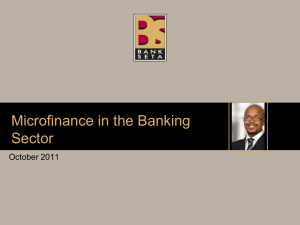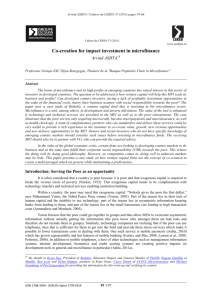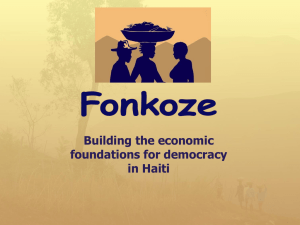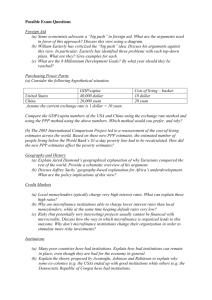effects of agri-fishery microfinance program of the agricultural credit
advertisement
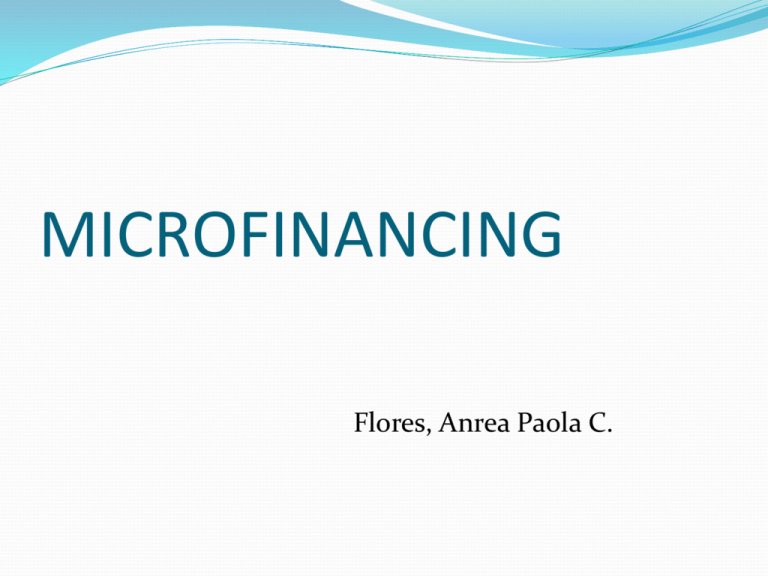
MICROFINANCING Flores, Anrea Paola C. What is Microfinance? Microcredit, or microfinance, is banking the unbankables, bringing credit, savings and other essential financial services within the reach of millions of people who are too poor to be served by regular banks, in most cases because they are unable to offer sufficient collateral. The end goal is to see more institutions utilize multichannels to deliver a wide range of financial services to more Filipinos, including those who were previously excluded from the system and remain unbanked. In 2000, the BSP was mandated by the General Banking Law of 2000, through sections 40, 43 and 44, to recognize microfinance as a legitimate banking activity and to set the rules and regulations for its practice within the banking sector. In the past eight years, the BSP has issued seventeen Circulars/ Issuances and undertaken major activities and initiatives for microfinance. With the objective of building an inclusive financial system, the BSP maintained the following: 1) to provide the enabling policy and regulatory environment, 2) to increase the capacity of the BSP and the banking sector in microfinance, SME finance operations, and 3) to promote and advocate for the development of a sound, sustainable and truly inclusive financial system. Enabling Policy and Regulatory Environment The policy and regulatory environment for microfinance within the banking sector has, to a large extent, already been set in place. Approval of the Housing Microfinance Product (14 February 2008) – The Monetary Board recognized the application of microfinance best practices in the delivery of adequate and appropriate housing finance for microfinance clients. Issuance of Circular 607 on Microfinance Reportorial Requirements (30 April 2008) – The Circular provides guidelines for reporting by the banks with retail microfinance operations to improve data capture and monitoring of banks’ microfinance activities. Issuance of Circular 608 Liberalizing Acceptance of Valid Identification Cards (20 May 2008) – The Circular provides guidelines governing the acceptance of valid identification cards for all types of financial transactions by banks and non-banks financial institutions under BSP supervision, including financial transactions involving overseas Filipino workers (OFWs). Issuance of Circular 624 on Branching Guidelines (13 October 2008) – The Circular further provides opportunities for banks, including banks with microfinance operations, to reach new and larger markets with a liberalized branching regime. Issuance of Circular 625 Implementing the Provisions of the Magna Carta for Micro, Small and Medium Enterprises or Republic Act 9501 (14 October 2008) – The Circular provides the revised rules and regulations governing the mandatory allocation of credit resources to micro, small and medium enterprises of 8% and 2% of banks’ total loan portfolio, respectively. In the last ten years the “transformation” of microfinance non-governmental organizations (NGOs) into formal financial institutions have been taking place in the local and international microfinance industry. Becoming a regulated financial institution has become a strategic end-goal for some NGOs in order to achieve their objectives of sustainability and greater outreach. Advocacy for Relevant Legislation • Credit Information System Act– Signed into law on September 1, 2008 as Republic Act 9510. For microfinance, this initiative hopes to increase the access to credit by micro, small and medium enterprises as well as answer problems of credit pollution and multiple borrowings. • Amendments to the Cooperative Code of the Philippines –The amendments also aim to develop a clear regulatory framework that will level the playing field among cooperative banks and other types of banks as well as cooperatives that provide financial services. • Amendments to the Agri-Agra Law –The amendments aim to ensure the availability of more credit to farmers, fisherfolks and agrarian reform beneficiaries and to ascertain that alternative compliance mechanisms are focused on agri/agra clients. • Microenterprise Development Institution Bill –aims to recognize and support the role of non-stock, non-profit institutions that provide a holistic approach to poverty alleviation with microfinance as the foundation (microfinance NGOs or MEDIs). Training and Capacity Building Toward this end, several initiatives were undertaken: Capacity Building within BSPOrientation for BSP Examiners on the SME Finance Training Provided by GTZ to Banks (30 January 2008) – The German Technical Cooperation provides select banks with technical assistance to strengthen their capacities to lend to SME clients. BSP-wide Microfinance Appreciation Course (March and August 2008) – A bank-wide seminar was open to all employees of the BSP to increase the general appreciation and knowledge of microfinance. Exposure Trip of the Microfinance Committee to the Negros Women for Tomorrow Foundation and Dungganon Bank (04 April 2008). - The visit aimed to further enrich the appreciation and understanding of microfinance by the Committee as the foundation for responsive and appropriate policy and regulatory issuances. Training Program for BSP Examiners on Supervision and Examination of Banks with Microfinance and SME Finance Operations – The Microfinance Committee approved the conduct of another series of seminars for examiners on supervision and examination of banks with microfinance operations. Capacity Building within Banking Sector Basic Rural and Thrift Banking Course with Microfinance – in 2008, 21 Basic Rural and 3 Thrift Banking Courses were offered to officers and staff of 22 banks. Good Governance and Credit Risk Management for Banks with Microfinance Operations – The Microfinance Committee approved the conduct of the seminar on good governance and credit risk managements for all banks with microfinance operations. Promoting and Advocating for Sustainable Microfinance and Financial Inclusion Assistance/ presentations/ orientations to Commercial and Investment Banks Assistance, Support and Active Involvement in Various Private Microfinance Advocacy Initiatives Coordination with Other Government Agencies Presentation to International Groups, Policy Makers and Regulators Background of the Study The Agri-Fishery Microfinance Program is one of the microlending programs under the Agro-Industry Modernization Credit and Financing Program (AFMP) which is the government’s umbrella financing program for agriculture and fisheries. The study will specifically examine the following issues: Did the farmer-borrowers utilized their loans for the intended purpose? What has been the effect of the loans availed under this program on the farm income of the farmerborrowers? How much was the contribution of the loan to the increase in income of the farmer-borrowers? What is the repayment performance of the farmerborrowers and the factors that affected their loan repayment performance? Description of the Program LBP provides portfolio rediscounting, working capital and term loans to qualified borrower institutions. Borrower organizations/institutions may be (a) organizations with farmer or fisher folk members that will utilize the credit funds to finance value chain activities of small farmers or fisher folks or (b) credit retailers that will extend agri fishery microfinance loans to small farming or fishing households. Program Features Eligible borrower organizations or institutions include the following: Bank Accredited Cooperatives and other Accredited Conduits of LBP. These are institutions that are currently accredited with Land Bank and have passed the Risk Asset Acceptance Criteria for microfinance. Bank Accredited Cooperatives and other Accredited Conduits that have yet to pass the Risk Asset Acceptance Criteria. These are institutions that are currently accredited with Land Bank but have yet to pass the RAAC for microfinance. Non-BACs/ Potential Newly Accessing Cooperatives and other organizations. These institutions are not accredited with Landbank but are considered critical in the delivery of financial services in the agri-fisheries sector. Types of financing facilities of the program (for borrower institutions): portfolio rediscounting working capital term loan Financing terms ( Borrower Institutions) Financial Facility Loan Maturity Mode of Payment Portfolio rediscounting 180 days Principal and interest upon maturity Working Capital loan 360 days Principal upon maturity but interest maybe monthly or quarterly Term loan 3 years Amortized quarterly payment on principal interest with grace period of six months on principal Description of the Cooperative SUMAPI has been an institution since 2006 that avails loans to the Landbank of the Philippines for the purpose of giving the farmer- borrowers the chance to avail loans that is within their capacity to repay. The amount of loan can be availed ranges from 20-90 thousand per farmer. End

